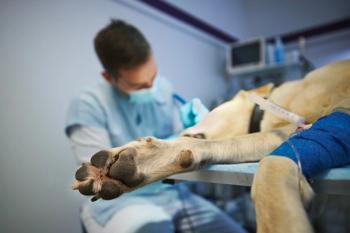
Vestibular disorders of dogs and cats (Proceedings)
Vestibular dysfunction causes varying degrees of loss of equilibrium causing imbalance and ataxia.
The vestibular system has two main functions
1. To maintain the visual image by stabilizing the eyes in space during head movement, and
2. To stabilize the position of the head in space - thus ensuring that the position of the body is stable.
Clinical Signs
Vestibular dysfunction causes varying degrees of loss of equilibrium causing imbalance and ataxia. Strength is not affected, and therefore paresis is not observed. As a rule, the disturbance is unilateral or asymmetrical, and the signs are those of an asymmetrical ataxia with preservation of strength.
Unilateral vestibular signs may result from either central (brain stem) or peripheral (labyrinth) disease. Signs of vestibular disease include: falling, rolling, tilting of the head, circling, nystagmus, positional strabismus (deviation of one eye in some head positions), and an asymmetrical ataxia.
Nystagmus
Disturbed vestibular input to the neurons innervating extra-ocular eye muscles results in abnormal nystagmus. Nystagmus probably occurs at some time during all types of vestibular disease. Nystagmus is an involuntary rhythmic oscillation of the eyeball that nearly always affects both eyes equally. Typically, nystagmus consists of a slow phase in one direction and a fast phase in the other. It is customary to describe nystagmus in terms of the fast phase, despite the fact that in most cases the slow phase may be directed towards the affected side. Nystagmus tends to occur early in the course of peripheral vestibular disease, and to disappear later.
Physiological nystagmus may be induced in normal animals. It occurs with normal turning of the head from side to side, or up and down (vestibular in origin), or after rotation (post-rotational nystagmus). If nystagmus occurs when the head is stationary, and there is no rotation or movement of the surroundings, it is called spontaneous nystagmus. Spontaneous nystagmus usually is pathological in origin and may be horizontal, rotatory, or vertical in direction. If nystagmus occurs only when the head is placed in an unusual position (e.g., laterally or dorsally), it is known as positional nystagmus. Nystagmus that consists of eye movements of the same velocity in each direction is termed pendulous nystagmus, and is not of vestibular origin. Pendulous nystagmus usually is associated with visual pathway deficits.
Abnormal Posture and Ataxia
Loss of co-ordination between head, trunk, and limbs, results in loss of balance. This may result in a head tilt. The trunk may fall, or even roll, to one side. The trunk may be flexed laterally. Animals tend to circle. These usually are circles with a small radius. It may be possible to elicit mild hypertonia and hyperreflexia in the limbs on one side.
An animal will often fall when attempting to shake its head. Vision will assist an animal to compensate for a vestibular system deficit. Blindfolding an animal with a vestibular lesion may accentuate the clinical signs.
Postural Reactions - Strabismus
When the head is extended in a tonic neck reaction, the eyeballs should remain in the center of the palpebral fissure in dogs and cats. This often fails to occur on the side of a unilateral vestibular disturbance, and results in a ventrally deviated eyeball. Occasionally, in vestibular disease, an eyeball is noticed to deviate ventrally or ventrolaterally without extension of the head and neck. This appears as a lower motor neuron strabismus, and may be corrected by moving the head into a different position, or by inducing the patient to move its eyeballs to gaze in different directions. This is referred to as vestibular strabismus. The ventrally deviated eyeball is on the side of the vestibular lesion. Occasionally, the opposite eyeball may appear to be deviated dorsally.
Peripheral Vestibular Disease
Peripheral lesions involve the middle and inner ear. Middle ear (bulla tympanica) lesions usually produce head tilt (ipsilateral to the lesion) only, in the absence of other signs. Horizontal or rotatory nystagmus also may be seen. Inner ear disease, which actually involves the receptors and vestibular nerve within the petrosal bone, usually produces other signs in addition to the ipsilateral head tilt - falling, rolling, circling, nystagmus, positional strabismus, asymmetrical ataxia.
Horner's syndrome (miosis, ptosis, enophthalmos) of the ipsilateral eye may be present with either middle or inner ear disease in dogs and cats, because the sympathetic trunk passes through the middle ear in close proximity to the petrosal bone.
The facial nerve may be affected in inner ear disease, as it courses through the petrosal bone in contact with the vestibulocochlear nerve. The primary characteristics of unilateral peripheral vestibular disease are: asymmetrical ataxia without deficits in postural reactions, and a horizontal or rotatory nystagmus that does not change in direction with different head positions. The fast phase of the nystagmus is directed away from the affected side.
Central Vestibular Disease
Any signs of brain stem disease in association with vestibular signs indicate that central involvement is present. The most frequent differentiating feature is a deficit in postural reactions, as central vestibular lesions most often result in paresis or loss of conscious proprioception. Alterations in mental status, or deficits in Vth or VIIth cranial nerves, also may be indicative of central disease. Nystagmus may be a key to differentiating central from peripheral disease. Nystagmus occurs in most central vestibular syndromes, and appears to be a permanent deficit. It is a positional nystagmus; therefore it may be present in some head positions (with respect to gravity), but not in others. Also the nystagmus may vary in direction with change in head position. Vertical nystagmus in any head position is most consistent with central vestibular disease.
Paradoxical Central Vestibular Syndrome
Unilateral lesions of the peripheral vestibular system produce a head tilt towards the side of the lesion. With few exceptions, the same occurs with lesions of the central components of the vestibular system. Exceptions to this rule are therefore termed "paradoxical". Some unilateral lesions of the central vestibular pathways, especially unilateral involvement of the flocculonodular lobe of the cerebellum or the supramedullary part of the caudal cerebellar peduncle, produce a head tilt and ataxia directed toward the side opposite to the lesion, and a nystagmus with the fast component towards the side of the lesion. Such lesions usually are space-occupying lesions. Usually these lesions will produce postural reaction deficits or additional cranial nerve abnormalities on the affected side, which aid in determining on which side a lesion is located.
Bilateral Vestibular Disease
Bilateral peripheral vestibular disease with complete loss of function is characterized by symmetrical ataxia and loss of balance of either side, with strength preserved. Postural asymmetry is not present. A characteristic "side-to-side" head movement often accompanies these signs. Abnormal nystagmus is not observed, and with bilateral destruction of the receptor organs, normal vestibular nystagmus cannot be elicited by head movement or caloric testing.
Diseases Causing Peripheral Vestibular Dysfunction
Anomalous
Congenital vestibular disease is reported in both purebred dogs and cats (GSD, Dobermann, English Cocker, Siamese and Burmese). Signs are usually unilateral (bilateral in Beagle and Akita). Onset is usually from birth to 3 months of age. Clinical signs include head tilt, ataxia, usually no nystagmus, ± deafness. Prognosis can be favorable with some animals improving with time due to compensation.
Metabolic
Hypothyroidism has been associated with polyneuropathy involving CN VII and VIII in adult dogs. Usually presents as unilateral disease and often progresses to bilateral involvement. Diagnosis is based on physical and neurological examination, thyroid panel and therapeutic trials (although no proven benefit of supplementation has been demonstrated). This presentation has also been associated with pituitary chromophobe adenomas. Prognosis is can be favorable with some animals improving with time, however residual deficits of CN VII are common. Hypoxia may affect the receptor organs.
Neoplasia
Neurofibroma/acoustic neuroma of CN VIII may occur. Usually unilateral signs, often involving CN VII. May affect central structures with time/growth. Neoplasia involving the petrous temporal bone; osteosarcoma, fibrosarcoma, chondrosarcoma, squamous cell carcinoma.
Infectious/Inflammatory
1. Otitis-media and otitis-interna: The most common cause of peripheral vestibular disease. Vestibular signs occur when the middle ear inflammation/infection directly or indirectly affects the function of the membranous labyrinth. Most cases are due to extension from the external ear, but this is not always the case.
A. Clinical signs
• Varying degrees of unilateral vestibular disease.
• Acute or chronic onset.
• ± Facial nerve dysfunction
• ± Horner's syndrome (small animals).
• ± Deafness (unilateral).
B. Small animals: Usually bacterial extension from otitis externa/media.
C. Treatment consists of long term antibiotic therapy, preferably based on culture and sensitivity. A minimum of 6 weeks therapy is usually required. Refractory otitis may require surgical intervention (bulla osteotomy/canal ablation).
2. Aural cholesteatoma: A form of epidermoid cyst that may be associated with otitis-media. Surgery may be required.
3. Inflammatory polyps of the middle ear in cats: Animals are usually 1-5 years of age with vestibular, ± auditory ± respiratory signs. The polyps may arise in the nasopharynx, and surgical removal via bulla osteotomy may be necessary for successful treatment.
Idiopathic
1. Canine idiopathic vestibular disease: "Old dog vestibular disease". Often misdiagnosed as a "stroke". Usually an acute or peracute onset that may be preceded by nausea and/or vomiting. The cause is unknown and diagnosis is by exclusion of other causes of peripheral vestibular disease. Treatment is supportive and prognosis is good with improvement seen in 72 hours and recovery usually in 10-14 days. A residual head tilt may be present. NB there should be no CN VII or sympathetic signs.
2. Feline idiopathic vestibular disease. There is no breed, age or sex predisposition, and disease may be unilateral or bilateral. Incidence is higher in July and August in the NE USA. Cause is unknown, and diagnosis, treatment and prognosis is similar to the canine disease.
Trauma
Involving petrous temporal bone. Signs can be very severe with marked circling/rolling, often requiring sedation. Sympathetic and CN VII signs may be seen. There may be otoscopic and radiographic/CT evidence of fractures and hemorrhage. Treatment is mainly supportive, and prognosis can be good if there is no central involvement.
Toxic
Ototoxicity may cause hearing loss, vestibular dysfunction or both. Topical therapy is the most common cause, however oral and parenteral toxicity is possible. Many drugs/agents are potentially toxic; the most common ones include the aminoglycoside antibiotics that can affect the hair cells, flocculonodular lobe and fastigial nucleus. Streptomycin tends to have vestibular effects, whereas neomycin, gentamycin, kanamycin, vankomycin tend to have more effect on the auditory system. Loop diuretics, cisplatin, propylene glycol and chlorhexidine have also been implicated in ototoxic disease. Treatment is to discontinue the use of the drug. Most hearing loss is permanent, however vestibular dysfunction if present may resolve. It is important to avoid application of topical agents into the external ear if the tympanic membrane is not intact, is inflamed or cannot be visualized. Use the safest drugs at appropriate doses. Most toxicity is associated with overdosage and prolonged exposure.
Note. Ototoxicity from topical agents may occur even if the tympanic membrane is intact!
Vascular
"Stroke" is a misnomer when used to refer to peripheral vestibular disease in dogs. The term refers to human cerebrovascular disease associated with chronic vascular disease leading to the acute blockage of a cerebral blood vessel or its rupture and subsequent hemorrhage. It occurs uncommonly in animals and signs should be referable to a central lesion (brainstem or cerebrum).
Diseases Causing Central Vestibular Dysfunction
Degenerative
Storage diseases. Inherited diseases of dogs and cats due to deficiency of a lysosomal enzyme. Slowly progressive onset usually before 1 year of age. Progressive disease with no treatment. Extremely RARE.
Neoplastic
Primary and Secondary (metastatic). Neurological signs are progressive. Tumors are usually found within the brainstem (gliomas, ependymomas, metastatic tumors) or involving the cerebellomedullary angle or surface of the brainstem (meningiomas, neurofibromas, choroid plexus tumours, lymphosarcoma). Diagnosis often requires advanced imaging and either surgical or CT guided needle biopsy. Treatment is often palliative and may include corticosteroids to reduce peritumoral edema. Surgical excision or debulking is generally more difficult in the brainstem compared to the superficial areas of the cerebrum, but is done regularly at UC Davis with good outcomes. Radiotherapy and chemotherapy may also be done depending on tumor type and location. Prognosis is generally guarded, but reasonable periods of remission/reduction of clinical signs can be achieved. It is VERY important to include a good minimum data base including metastasis check thoracic radiographs and abdominal imaging to rule out metastatic disease.
Nutritional
Thiamine deficiency. Generally seen in cats fed all fish diets (fish contains thiaminase). Thiamine deficiency causes spongy necrosis and hemorrhage of grey matter. Vestibular signs may be present early in the disease with progression to seizures, dilated pupils, cervical ventroflexion and death. Diagnosis is based on history, clinical signs, decreased blood thiamine and transketolase activity and response to therapy. Treatment is supportive with thiamine supplementation and diet management. Successful treatment is possible in the early stages.
Infectious
1. Bacterial: Uncommon. Extension of otitis media-interna. Treat with surgery and long term antibiotics, ideally based on culture and sensitivity results.
2. Viral.
A. Canine distemper virus: Dogs, sealions, lions, tigers affected. May or may not exhibit systemic signs. Diagnosis antemortem is difficult and is based on history, clinical signs, CSF analysis, serology and PCR. Treatment is supportive. Prognosis is guarded.
B. Feline infectious peritonitis: Nervous system lesions often affecting ependymal surfaces and meninges. May be associated with uveitis. Usually chronic progressive illness. A variety of CNS signs may be seen including vestibular disease. Diagnosis antemortem is difficult. History, coronavirus titres, MRI, increased serum globulin and often markedly abnormal CSF (Markedly raised protein with monocytic pleocytosis). Treatment supportive, may be transient response to corticosteroids. Prognosis poor.
C. Rabies: Can manifest with almost any neurological syndrome, however behavioral signs and ataxia are most common. Diagnosis is post mortem. There is no treatment. Suspect animals must be quarantined. Death normally occurs within 10-15 days.
D. d. West Nile Virus?
3. Protozoa
A. Neospora/Toxoplasmosis: Relatively uncommon infection causing vestibular signs in cats (toxo) and dogs (neospora and toxo). Respiratory and ocular signs may be more common. Myopathy may be seen in young dogs. Diagnosis antemortem may be difficult as serology can be difficult to interpret. PCR may be helpful in diagnosis. Treatment is with potentiated sulphonamides or clindamycin. Prognosis guarded once neurological signs are apparent.
4. Mycotic
A. Several mycotic agents cause granulomatous disease of the CNS in cats and dogs.
B. The more common agents include:
• Cryptococcus neoformans
• Coccidiomycosis immitis
• Blastomycosis
• Histoplasmosis
C. Cryptococcus is the only common agent, particularly in California. Involvement of the respiratory tract is common. Diagnosis is based on demonstration of the organism in CSF and serology. Treatment includes amphoteracin and the "azole" derivatives, particularly fluconazole. Prognosis with CNS involvement is poor.
Parasitic
Aberant migration and growth of parasites within the CNS is rare in dogs and cats.
Rickettsia
Rarely involves the CNS.
Inflammatory
1. Pathogen free inflammatory brain disease is common in the dog, and rare in the cat. Several distinct diseases are recognized, some of which appear to preferentially affect the brainstem cerebellum.
A. Granulomatous meningoencephalomyelitis (GME). Typically occurs in young to middle aged small breed dogs, but can be found in all breeds. Signs may be localized or multifocal/diffuse. Tentative diagnosis is based on inflammatory CSF, advanced imaging and biopsy. The disease is progressive but may respond to anti-inflammatory or immunomodulatory drugs such as corticosteroids. Radiotherapy has been advocated in some circumstances. Prognosis is poor in the long term and most animals die in 3-12 months. A clinical research project is underway at UC Davis as of June 1 2004 studying GME in dogs. Contact Karen Vernau at UCD for more information.
B. Necrotising encephalitis of Yorkshire Terriers. A progressive inflammatory disease predominantly affecting the brainstem. Definitive diagnosis is by biopsy or at post mortem. Treatment with antiinflammatory drugs has been unsuccessful and prognosis is poor.
Trauma
Vestibular signs may be due to primary damage, or secondary to raised intracranial pressure, herniation or progression of hemorrhage etc. Serial neurological examinations are essential to monitor progress. CT is the imaging modality of choice in the 1st 24 hours (for acute hemorrhage and bony involvement). MRI is preferential for imaging the brain after this period.
Treatment depends on the injuries sustained and may include the use of hyperosmolar agents such as mannitol to decrease intracranial pressure, supportive intensive care and surgery to repair fractures and provide decompression. Prognosis depends on the extent of brainstem involvement and the underlying cause.
Toxic
Metronidazole. Doses of metronidazole over 60 mg/kg daily have been associated with acute onset of vestibular signs, often with a marked vertical nystagmus and ataxia. Other CNS signs such as seizures may be apparent. Diagnosis is based on history and clinical signs and prognosis is good if the diagnosis is made early and the administration stopped.
Vascular
Hemorrhage, stroke, infarction are uncommon in domestic species but can occur secondary to hypothyroidism, coagulopathies, hyperviscosity syndromes, amyloidosis, septicemia and cardiac disease.
Newsletter
From exam room tips to practice management insights, get trusted veterinary news delivered straight to your inbox—subscribe to dvm360.






